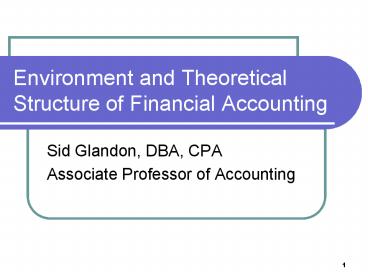Environment and Theoretical Structure of Financial Accounting PowerPoint PPT Presentation
1 / 17
Title: Environment and Theoretical Structure of Financial Accounting
1
Environment and Theoretical Structure of
Financial Accounting
- Sid Glandon, DBA, CPA
- Associate Professor of Accounting
2
Financial Accounting
- Financial reporting is the process of providing
relevant financial information to third-party
users - Investors
- Creditors
- Financial intermediaries
3
Capital Markets
- Primary markets
- Debt and equity instruments are sold based on
anticipated cash flows - Interest
- Dividends
- Capital gains
- Secondary market
- Investors trade
4
Accrual vs. Cash Accounting
- Accrual accounting provides a more realistic
representation of periodic financial results
5
Financial Statements
- Balance Sheet
- Statement of Income
- Statement of Cash Flows
- Statement of Shareholders Equity
- Notes to the Financial Statements
6
Standards
- Establishment of accounting standards is a
political process - Standards setting bodies
- Committee on Accounting Procedures
- Accounting Principles Board
- Financial Accounting Standards Board
7
Financial Accounting and Reporting Standards
- Securities and Exchange Commission
- American Institute of Certified Public
Accountants (AICPA) - Committee on Accounting Procedures (CAP)
- Accounting Principles Board (APB)
- Financial Accounting Standards Board (FASB)
8
Financial Reporting Reform
- Public Company Accounting Reform and Investor
Protection Act of 2002 Sarbanes-Oxley (SOX) - Public Company Accounting Oversight Board (PCAOB)
- Standards setting body for publicly traded
companies and their auditors
9
Conceptual Framework
- Statements of Financial Accounting Concepts
- 1 Objectives of Financial Reporting
- 2 Qualitative Characteristics of Accounting
Information - 6 Elements of Financial Statements
- 5 Recognition and Measurement in Financial
Statements
10
Objectives of Financial Reporting
- Provide information
- Useful for decision making
- Helps in predicting cash flows
- About economic resources, claims to resources and
changes in resources and claims
11
Qualitative Characteristics
- Understandability (user-specific quality)
- Decision Usefulness (overriding objective)
- Primary qualities
- Relevance
- Predictive value
- Feedback value
- Timeliness
- Reliability
- Verifiability
- Neutrality
- Representational faithfulness
- Secondary
- Comparability
- Consistency
- Materiality
12
Constraints
- Cost effectiveness
- Materiality
- Conservatism
13
Elements of Financial Statements
- Assets
- Liabilities
- Equity
- Investments by owners
- Revenues
- Gains
- Expenses
- Losses
- Comprehensive income
14
Recognition and Measurement
- Recognition
- Item is an element that is measurable, relevant
and reliable - Measurement
- Unit of measurement
- Attribute to be measured
- Historical cost
- Net realizable value
- Present value of future cash flows
15
Recognition and Measurement Concepts
- Assumptions
- Economic entity
- Going concern
- Perodicity
- Monetary unit
- Principles
- Historical cost
- Realization
- Matching
- Full disclosure
16
AICPA Code of Ethics
- Preamble, self-discipline
- Responsibilities, sensitive professional and
moral judgments - Public Trust, serve the public interest
- Integrity, highest sense of integrity
- Objectivity and Independence, objective and
independent in fact and appearance - Due Care, professionals technical and ethical
standards - Scope and Nature of Services, qualified to provide
17
Model for Ethical Decisions
- Step 1, Determine the facts of the situation
- Step 2, Identify the ethical issue and the
stakeholders - Step 3, Identify the values related to the
situation - Step 4, Specify the alternative courses of action
- Step 5, Evaluate the courses of action in terms
of their consistency with the values identified - Step 6, Identify the consequences of each
possible course of action - Step 7, Make your decision and take any indicated
action

